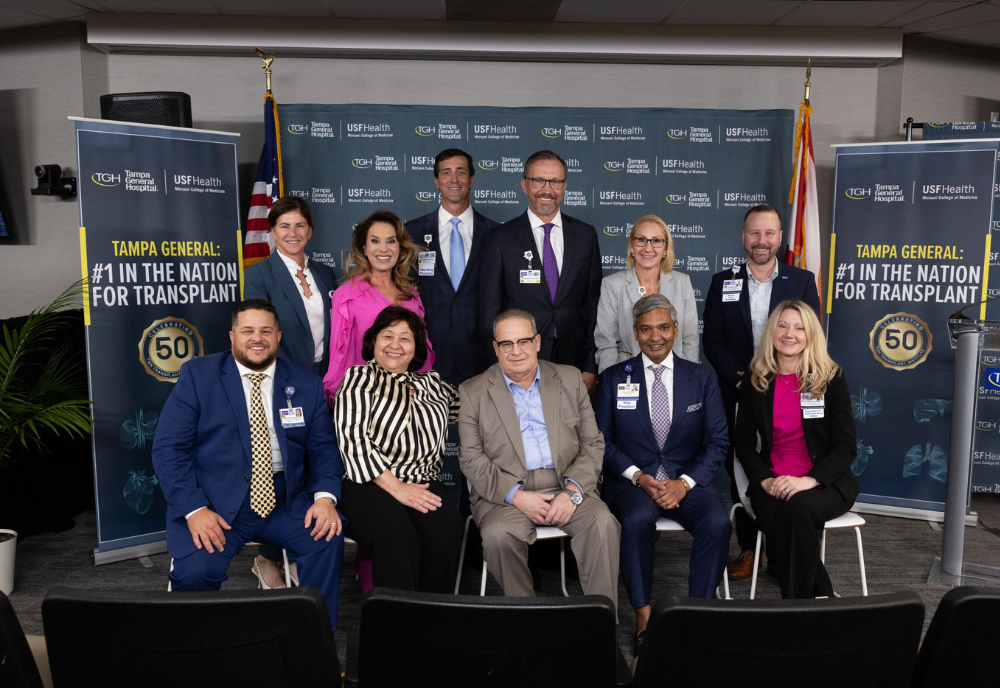Transplant surgeons at USF Health and Tampa General Hospital (TGH) have successfully performed the world’s first recorded bloodless heart-liver transplant. The groundbreaking procedure was led by Kiran Dhanireddy, MD, vice president and chief of the TGH Transplant Institute and associate professor of surgery with the USF Health Morsani College of Medicine, and Gundars Katlaps, MD, surgical director of the lung transplant program and an associate professor of surgery in the Morsani College of Medicine.
Finding new ways to tackle complex medical issues is what makes academic medical centers such a valuable resource for patients, said Charles J. Lockwood, MD, MHCM, executive vice president of USF Health and dean of the Morsani College of Medicine.
“Our physicians have the expertise to provide complex care for patients who have no other options,” Dr. Lockwood said. “This kind of innovative problem-solving and multidisciplinary care is why patients at academic medical centers have been shown to have better health outcomes. I’m tremendously proud of our physicians for their leadership in this arena.” Dr. Lockwood also serves as executive vice president and chief academic officer at Tampa General.
“As a true academic health system, our transplant team has access to cutting-edge technologies, innovative techniques and the latest research available,” explained John Couris, president and CEO of Tampa General Hospital. “That academic difference, combined with Tampa General’s world-class team members and providers, is what positions our Transplant Institute as a national leader and the number one transplant center by volume. It’s why patients come to us to find possibility in seemingly impossible circumstances.”
The patient, who was diagnosed with both coronary artery disease and fatty liver disease, conditions associated with metabolic syndrome, waited more than 18 months for a transplant procedure that needed to be performed without the use of blood products, requiring the transplant team to perform the dual-organ transplant as a bloodless surgery — a rare and highly complex endeavor.
“The success of this first-of-its-kind procedure is a true testament to the power of academic medicine, which enabled us to assemble a team with unmatched clinical expertise. Meticulous surgical technique and coordinated multidisciplinary perioperative care allow us to deliver the best possible outcomes for our patients,” said Dhanireddy. “Unfortunately, far too many patients do not have access to these resources in their local communities. Often, they need to travel considerable distances and face delays in care. At the TGH Transplant Institute, we focus on providing equitable care for patients in the Tampa Bay area, across the state of Florida, and even from other parts of the country.”
While the first bloodless single-organ transplant was performed in 1986, the discipline of bloodless transplant surgery is still not commonly available in most health systems. The field is continuously evolving, with the first recorded bloodless heart-kidney transplant having only been performed earlier this year. As the volume of bloodless transplant surgeries has increased, overall success and survival rates have followed suit.
In addition to expanding access to transplant care for patients who are unable to receive blood products due to medical contraindications or religious beliefs, research has shown significant benefits to avoiding or reducing the use of blood products, including faster recovery time and reduced risk of infections, which has prompted patient blood management programs to advocate for approaches that optimize the use of a patient’s own blood and minimize the need for blood transfusions when medically possible.
“The patients we see already face several obstacles throughout their care journeys, including delays or inequities in the organ allocation process and lack of access to specialized expertise where they live. A patient’s inability to receive blood products — whatever the reason — should not be one of them,” said Katlaps. “Our team is incredibly proud to have not only made history with this important procedure, but to have provided lifesaving care that our patient wouldn’t have been able to receive anywhere else in the world.”

